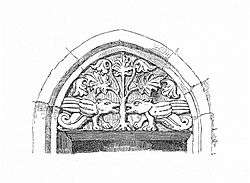Égig érő fa
The égig érő fa ("sky-high tree"), also called életfa ("tree of life"), világfa ("world tree"), or tetejetlen fa ("tree without a top"), is an element of Hungarian shamanism and native faith, and a typical element of Hungarian folk art and folk tales, and also a distinct folk tale type.

Several of these tales have versions in the Transylvanian, Germanic, Romanian, Romani, Serbian, Croatian, Bulgarian, Turkish and other cultures in Asia, but the origin of the Hungarian tales goes back to the táltos traditions of Hungarians. The "táltosok" (shamans) are the humans who are entitled to climb up the égig érő fa and wander in the seven or nine layers of the sky.
One version of these tale is about the "kiskondás" (small swineherd) who climbs up the tree to save the princess who is held captive by a dragon (as told in the Világhírű Szép Miklós tale). The tree is a frequent element of certain funny tales, in which for example a gypsy climbs up into heaven and then down into hell.
The world tree often grows out of a reindeer or a horse. It often carries among its branches the Sun and the Moon. This latter concept is typical of Finnic and Siberian people. The tree often stands on the world mountain, with its top in the sky and its roots in hell, where snakes and toads live. In the tales birds often sit on the tree, for example eagles, hawks or the mythical Hungarian bird, the turul.
See also
- Hollófernyiges
- Yggdrasil
- Hungarian Folktales (TV series) -"Magyar Népmesék II" (1979#2, "Az égig érő fa")